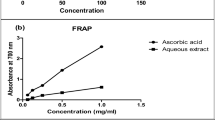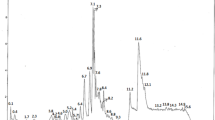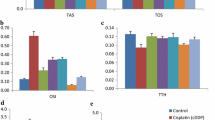Abstract
In this study, we investigated the antioxidant and protective properties of date fruit aqueous extract (DFAE) on trichloroacetic acid (TCA)-induced nephrotoxicity in rat. Oral administration of TCA as drinking water (0.5 and 2 g/L) daily for 2 months caused nephrotoxicity as evident by elevated levels of plasma creatinine, urea, and uric acid. Activity of antioxidant enzymes, catalase (CAT) and glutathione peroxidase (GPx), was decreased, whereas superoxide dismutase (SOD) activity and malondialdehyde (MDA) level were increased along with histopathological injuries. The oral administration of DFAE (4 mL/kg/day) to TCA-treated groups proved some significant correction by increasing the antioxidant activity of the CAT and GPx enzymes and normalizing the SOD activity and the MDA level (p < 0.05). It also protected kidney's histology and normalized the functions of this organ. It could be concluded that DFAE has a protective role against TCA-induced oxidative stress in rat, thereby protecting the renal tissue from TCA-induced damage.



Similar content being viewed by others
References
Acharya S, Mehta K, Rodriguez S (1995) Administration of subtoxic doses of t-butyl alcohol and trichloroacetic acid male Wistar rats to study the interactive toxicity. Toxicol Lett 80:97–104
Acharya S, Mehta K, Rodriguez S, Pereira J, Krishnan S, Rao CV (1997) A histopathological study of liver and kidney in male Wistar rats treated with subtoxic doses of t-butyl alcohol and trichloroacetic acid. Exp Toxicol Pathol 49:369–373
Aebi H (1984) Catalase in vitro. Methods Enzymol 105:121–126
AL-Farsi M, Alasalva C, Morris A, Baron M, Shahidi F (2005) Comparison of antioxidant activity, anthocyanins, carotenoids, and phenolics of three native fresh and sun-dried date (Phoenix dactylifera L.) varieties growth in Oman. J Agric Food Chem 53:7592–7599
Ali A, Abdu S, Alansari S (2011) Renoprotective effect of date fruit extract on ochratoxin (A) induced-oxidative stress in distal tubules of rat: a light and electron microscopic study. Kidney Res J 1:13–23
Al-Qarawi AA, Abdel-Rahman H, Mousa HM, Ali BH, El-Mougy SA (2008) Nephroprotective action of Phoenix dactylifera in gentamicin-induced nephrotoxicity. Pharm Biol 46:227–230
Austin EW, Okita JR, Okita RT, Larson JL, Bull RJ (1995) Modification of lipoperoxidative effects of dichloroacetate and trichloroacetate is associated with peroxisome proliferation. Toxicol Res 97:59–69
Austin EW, Parrish JM, Kinder DH, Bull RJ (1996) Lipid peroxidation and formation of 8-hydroxydeoxyguanosine from acute doses of halogenated acetic acids. Fund Appl Toxicol 31:77–82
Barber DA, Harris SR (1994) Oxygen free radicals and antioxidants. Am J Pharmacol l534:26–35
Beyer WE, Fridovich I (1987) Assaying for superoxide dismutase activity: some large consequences of minor changes in conditions. Anal Biochem 161:559–566
Bradford MM (1976) A rapid and sensitive method for the quantization of microgram quantities of protein utilizing the principle of protein–dye binding. Anal Biochem 72:248–254
Brand-Williams W, Cuvelier M, Berset C (1995) Use of a free radical method to evaluate antioxidant activity. Food Sci Technol-Leb 28:25–30
Buege AJ, Aust ST (1978) Microsomal lipid peroxidation. Methods Enzymol 52:302–310
Celik I (2007) Determination of toxicity of trichloroacetic acid in rats: 50 days drinking water study. Pestic Biochem Phys 89:39–45
Celik I, Isik I (2008) Determination of chemopreventive role of Foeniculum vulgare and Salvia officinalis infusion on trichloroacetic acid-induced increased serum marker enzymes lipid peroxidation and antioxidative defense systems in rats. Nat Prod Res 22:66–75
Celik I, Tuluce Y (2007) Elevation protective role of Camellia sinensis and Urtica dioica infusion against trichloroacetic acid-exposed in rats. Phytother Res 21:1039–1044
Celik I, Temur A, Isik I (2009) Hepatoprotective role and antioxidant capacity of pomegranate (Punica granatum) flowers infusion against trichloroacetic acid-exposed in rats. Food Chem Toxicol 47:145–149
Conklin KA (2000) Dietary antioxidants during cancer chemotherapy: impact on chemotherapeutic effectiveness and development of side effects. Nut Cancer 37:1–18
Culloch AMC (2002) Trichloroacetic acid in the environment. Chemosphere 47:667–686
Duncan BD (1957) Multiple ranges tests for correlated and heteroscedastic means. Biometrics 13:359–364
Deneke SM, Fanburg BL (1989) Regulation of cellular glutathione. Am J Physiol 257:L163–L173
Doha MA, Al-Okbi SY (2004) In vivo evaluation of antioxidant and anti-inflammatory activity of different extracts of date fruits in adjuvant arthritis. Pol J Food Nutr Sci 13:397–402
Eid NMS, Al-Awadi B, Vauzour D, Oruna-Concha MJ, Spencer JPE (2013) Effect of cultivar type and ripening on the polyphenol content of date palm fruit. J Agric Food Chem 61:2453–2460
EL Arem A, Saafi EB, Mechri B, Lahouar L, Issaoui M, Hammami M, Achour L (2012) Effects of the ripening stage on phenolic profile, phytochemical composition and antioxidant activity of date palm fruit. J Agric Food Chem 60:10896–10902
Fang YZ, Yang S, Wu G (2002) Free radicals, antioxidant and nutrition. Nut 18:872–879
Flohe L, Gunzler WA (1984) Assays of glutathione peroxidase. Methods Enzymol 105:114–121
Freeman BA, Crapo JD (1981) Hyperoxia increases oxygen radical production in rat lung and lung mitochondria. J Biol Chem 256:10986–10992
Halliwell B (1996) Oxidative stress, nutrition and health. Experimental strategies for optimization of nutritional antioxidant intake in humans. Free Radic Res 25:57–74
Kang DH, Nakagawa T, Feng L, Watanabe S, Han L, Mazzali M, Truong L, Harris R, Johnson RJ (2002) A role for uric acid in the progression of renal disease. J Am Soc Nephrol 13:2888–2897
Kawada N, Seki S, Inoue M, Kuroki T (1998) Effect of antioxidants, resveratrol, quercetin, and N-acetylcysteine, on the functions of cultured rat hepatic stellate cell sand Kupffer cells. Hepatol 27:1265–1274
Larson JL, Bull RJ (1992) Metabolism and lipoperoxidative activity of trichloroacetate and dichloroacetate in rats and mice. Toxicol Appl Pharm 115:268–277
Liu SC, Lin JT, Wang CK, Chen HY, Yang DJ (2009) Antioxidant properties of various solvent extracts from lychee (Litchi chinenesis Sonn.) flowers. Food Chem 114:577–581
Lynch, RM (1974) Technique de laboratoire médicale et pathologie Clinique 2ième édition. Tome 2-130, chapitre XLIP. 1155.
Manda K, Bhatia AL (2003) Role of beta carotene against acetaminophen-induced hepatotoxicity in mice. Nutr Res 23:1097–1103
Mather GG, Exon JH, Koller LD (1990) Subchronic 90-day toxicity of dichloroacetic and trichloroacetic acid in rats. Toxicol Res 64:71–80
Michael J, Sircar S (2010) Chronic renal failure. In: Michael J (ed) Fundamentals of medical physiology, 1st edn. Thieme Medical, New York, p 633
Mitchell JR, Jollow DJ, Potter WZ, Gillette JR, Brodie BB (1973) Acetaminophen induced hepatic necrosis. IV. Protective role of glutathione. J Pharmacol Exp Ther 187:211–215
Nezelof C, Golle H (1972) Technique microscopique. Flammarison, Paris
Nitha B, Janardhanan KK (2008) Aqueous-ethanolic extract of morel mushroom mycelium Morchella esculenta, protects cisplatin and gentamicin induced nephrotoxicity in mice. Food Chem Toxicol 46:3193–3199
Onuh SN, Ukaejiofo EO, Achukwu PU, Ufelle SA, Okwuosa CN, Chukwuka CJ (2012) Haemopoietic activity and effect of crude fruit extract of Phoenix dactylifera on peripheral blood parameters. Int J Biol Med Res 32:1720–1723
Pandey KB, Rizvi SI (2009) Plant polyphenols as dietary antioxidants in human health and disease. Oxid Med Cell Longev 2(5):270–278
Pereira MA, Kramer PM, Conran PB, Tao L (2001) Effect of chloroform on dichloroacetic acid and trichloroacetic acid-induced hypomethylation and expression of the c-myc gene and on their promotion of liver and kidney tumors in mice. Carcinog 22:1511–1519
Prasad AS, Bao B, Beck FWJ, Kuck O, Sarkar FH (2004) Antioxidant effect of zinc in humans. Free Rad Biol Med 37:1182–1190
Prakasam A, Sethupathy S, Lalitha S (2001) Plasma and RBCs antioxidant status in occupational male pesticide sprayers. Clin Chim Acta 310:107–112
Puri HS (2003) Rasayana: ayurvedic herbs for longevity and rejuvenation. J Altern Complement Med 9:331–332
Ragab AR, Elkablawy MA, Sheik BY, Baraka HN (2013) Antioxidant and tissue-protective studies on Ajwa extract: dates from al Madinah Al-Monwarah, Saudia Arabia. J Environ Anal Toxicol 3:163. doi:10.4172/2161-0525.1000163
Roussel AM, Ferry M (2002) Oxidative stress, nutrition and aging. Nut Clin Metabol 16:285–291
Rovin BH, Phan LT (1998) Chemotactic factors and renal inflammation. Am J Kidney Dis 31:1065–1084
Saafi-Ben Salah EB, EL Arem A, Louedi M, Saoudi M, El feki AF, Zakhama A, Najjar MF, Hammami M, Achour L (2012) Antioxidant-rich date palm fruit extract inhibits oxidative stress and nephrotoxicity induced by dimethoate in rat. J Physiol Biochem 68:47–58
Saafi EB, Louedi M, El Feki AF, Zakhama AF, Najjard MF, Hammami M, Achour L (2011) Protective effect of date palm fruit extract (Phoenix dactylifera L.) on dimethoate induced-oxidative stress in rat liver. ExpToxicol Pathol 63:433–441
Salvi A, Carrupt P, Tillement J, Testa B (2001) Structural damage to proteins caused by free radicals: assessment, protection by antioxidants, and influence of protein binding. Biochem Pharmacol 61:1237–1242
Sandhar HK, Kumar B, Prasher S, Tiwari P, Salhan M, Sharma P (2011) A review of phytochemistry and pharmacology of flavonoids. Int Pharma Sci 1: 25-41
Sedlak J, Lindsay RH (1968) Estimation of total, protein-bound, and nonprotein sulfhydryl groups in tissue with Ellman's reagent. Anal Biochem 25:192–205
Singer PC, Obelensky A, Griner A (1995) DBPs in chlorinated North Carolina drinking waters. J Am Water Works Assoc 87:83–92
Srinivasan R, Chandrasekar MJN, Nanjan MJ, Suresh B (2007) Antioxidant activity of Caesalpinia digyna root. J Ethnopharmacol 113:284–291
Tahraoui A, El-Hilaly J, Israili ZH, Lyoussi B (2007) Ethnopharmacological survey of plants used in the traditional treatment of hypertension and diabetes in southeastern Morocco (Errachidia province). J Ethnopharmacol 110:105–117
Vayalil PK (2002) Antioxidant and antimutagenic properties of aqueous extract of date fruit (Phoenix dactylifera L. Arecaceae). J Agric Food Chem 50:610–617
Vayalil PK (2012) Date fruits (Phoenix dactylifera Linn): an emerging medicinal food. Crit Rev Food Sci Nutr 52:249–271
Waliszevski SM, Sedus VTP, Waliszevski KN (1996) Detection of some organochlorine pesticides in cow's milk. Food Addit Contam 13:231–235
Weyers A, Ugnia LI, Ovando HG, Gorla NB (2008) Antioxidant capacity of vitamin C in mouse liver and kidney tissues. Biocell 32:27–31
Zaid A (1999) Date palm cultivation. Plant Production and Protection Paper. Rome: United Nations FAO
Zangiabadi N, Asadi-Shekaari M, Sheibani V, Jafari M, Shabani M, Asadi AR, Tajadini H, Jarahi M (2011) Date fruit extract is a neuroprotective agent in diabetic peripheral neuropathy in streptozotocin-induced diabetic rats: a multimodal analysis. Oxid Med Cell Longev doi:10.1155/2011/976948
Zhang CR, Aldosari SA, Vidyasagar PSPV, Nair KM, Nair MG (2013) Antioxidant and anti-inflammatory assays confirm bioactive compounds in Ajwa date fruit. J Agric Food Chem 61:5834–5840
Acknowledgments
We gratefully acknowledge Prof. Zohra Haouas for their help in the histopathological section.
Conflict of interest
On behalf of all authors, the corresponding author states that there is no conflict of interest.
Author information
Authors and Affiliations
Corresponding authors
Rights and permissions
About this article
Cite this article
El Arem, A., Zekri, M., Thouri, A. et al. Oxidative damage and alterations in antioxidant enzyme activities in the kidneys of rat exposed to trichloroacetic acid: protective role of date palm fruit. J Physiol Biochem 70, 297–309 (2014). https://doi.org/10.1007/s13105-013-0302-3
Received:
Accepted:
Published:
Issue Date:
DOI: https://doi.org/10.1007/s13105-013-0302-3




